

Damion Smy
Suzuki Fronx recalled after seatbelt failure sparks ‘urgent investigation’
6 Hours Ago
Want a small SUV but prefer a car-like drive? The Ford Focus Active and Mazda CX-30 are two of the very best – but which is our pick?

Marketplace Editor
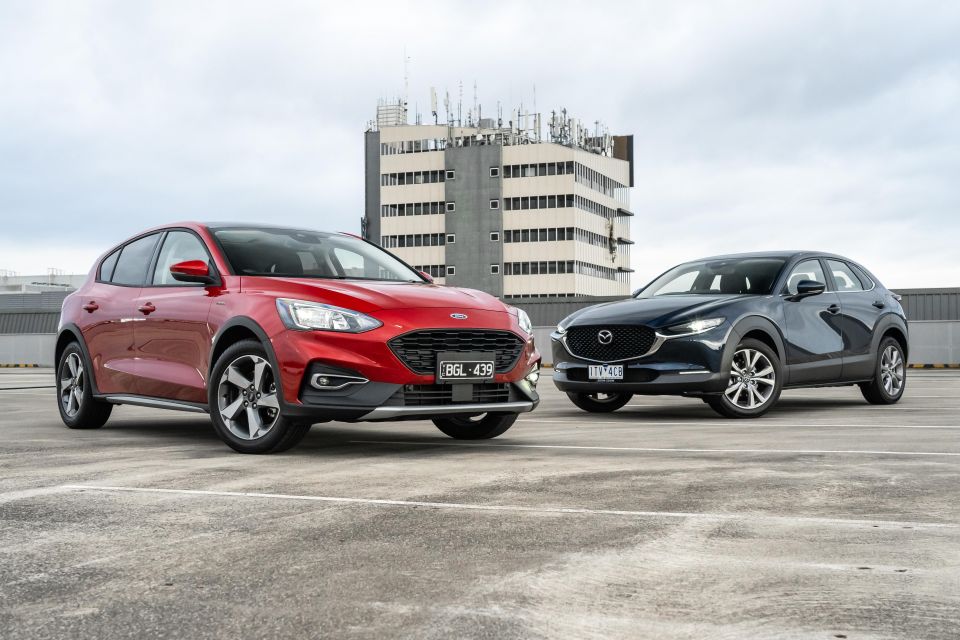

Marketplace Editor
Crossovers and SUVs are all the rage – I’ve written that so many times now – but the reality is these are what the majority of people want.
I can’t tell you how many family members and friends have told me they want their next car to be a small or medium SUV, no matter how much I try to convince them the equivalent passenger hatchback might be just as good, if not better.
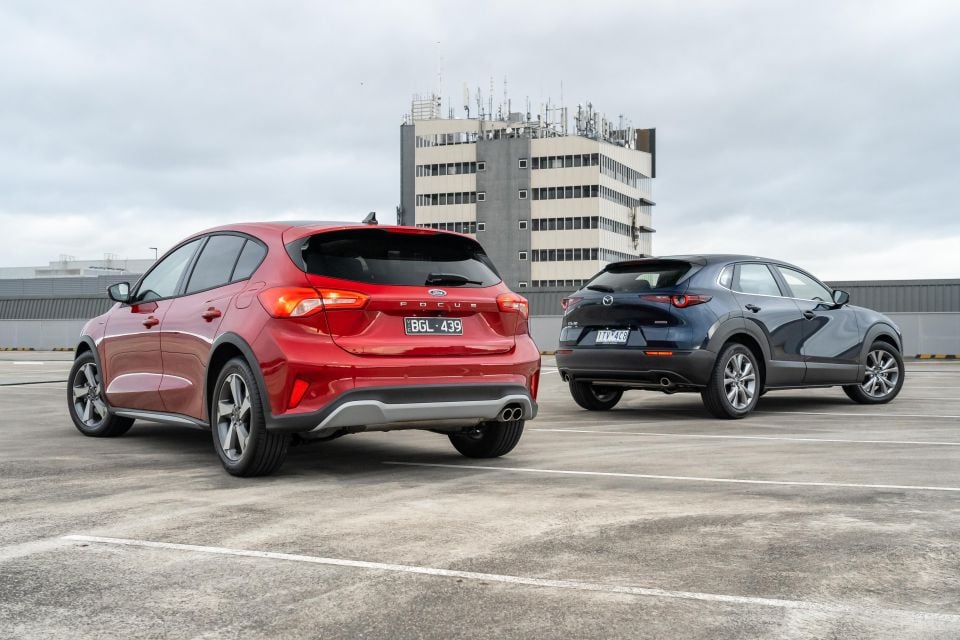
The heart wants what it wants, and manufacturers seem to know the market very well. Take the two cars we have on test – the 2021 Ford Focus Activeand2021 Mazda CX-30 G20 Evolve.
Both are closely related to hatchbacks (the Focus and Mazda 3) but offer some styling enhancements and the benefits of an elevated driving position. They also offer more car-like dynamics and proportions compared to some rivals like the Kia Seltos and Mitsubishi ASX.
Which of these should you buy?
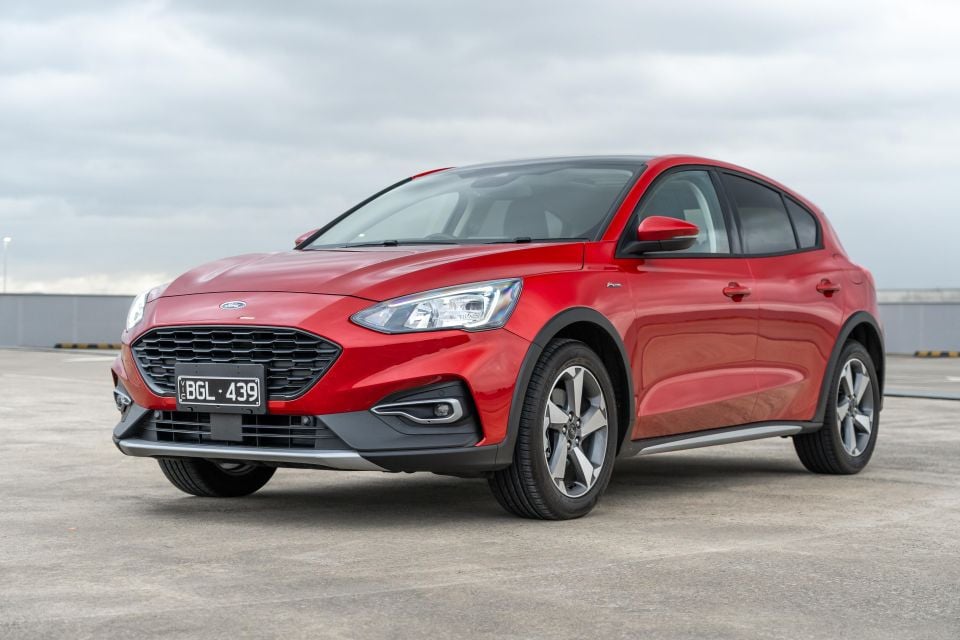
The 2021 Ford Focus Active is one of just two non-performance-oriented variants in the Focus line-up locally, and is priced from a sharp $30,990 before on-road costs.
Our test car came fitted with a few options, though. The Driver Assistance Pack (adaptive cruise control, lane centring, blind-spot monitoring and rear cross-traffic assist) adds $1250, the panoramic sunroof pack $2000, and Fantastic Red prestige paint $650. This brings the as-tested sticker to $34,890 plus on-roads.
Drive-away, that works out to an RRP of $39,312, though currently Ford Australia is advertising a base drive-away price of $32,690 – $36,590 drive-away if you add the value of the options on our tester.
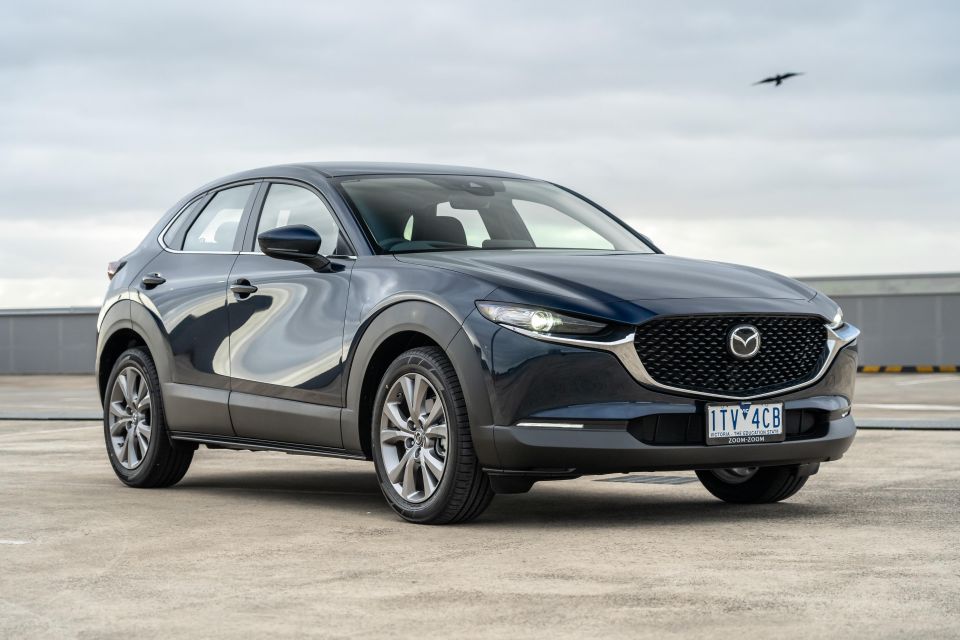
Meanwhile, the 2021 Mazda CX-30 G20 Evolve starts dearer at $31,590 before on-road costs. Our test car’s Deep Crystal Blue paint is no-cost, and it didn’t come fitted with any options – so as-tested it’s $36,488 drive-away.
Mazda’s $1500 Vision Technology Pack is worth considering. It adds a 360-degree camera, front cross-traffic alert, front parking sensors, driver monitoring, and a system called ‘Cruising & Traffic Support’, which is essentially like a traffic jam assist function assisting with accelerating, braking and lane keeping.
So while the recommended retail pricing puts the Focus Active at a few grand more as tested, current national drive-away pricing places these two rivals within $102 of each other. A perfect match-up, it seems.
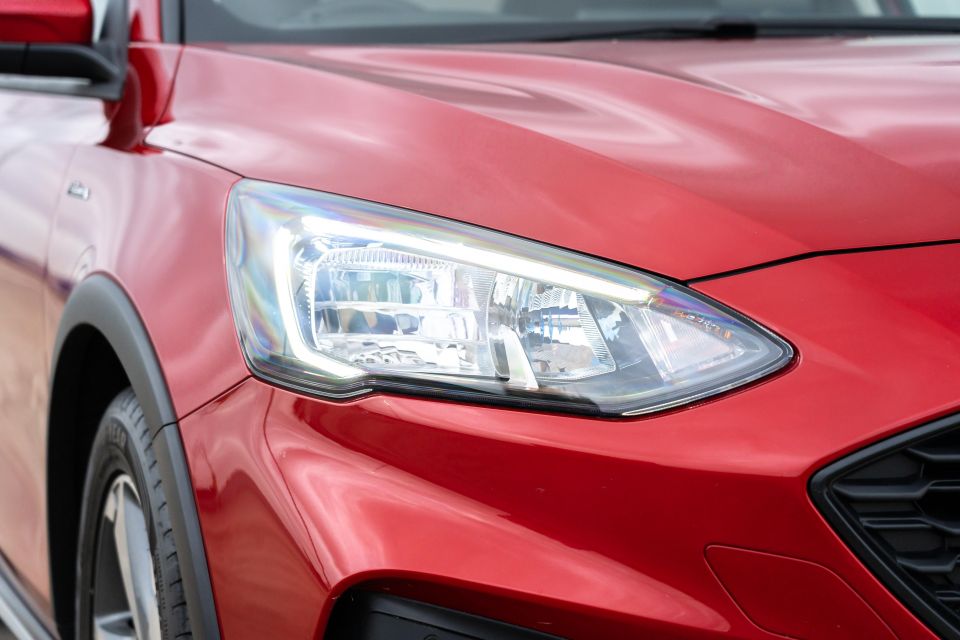
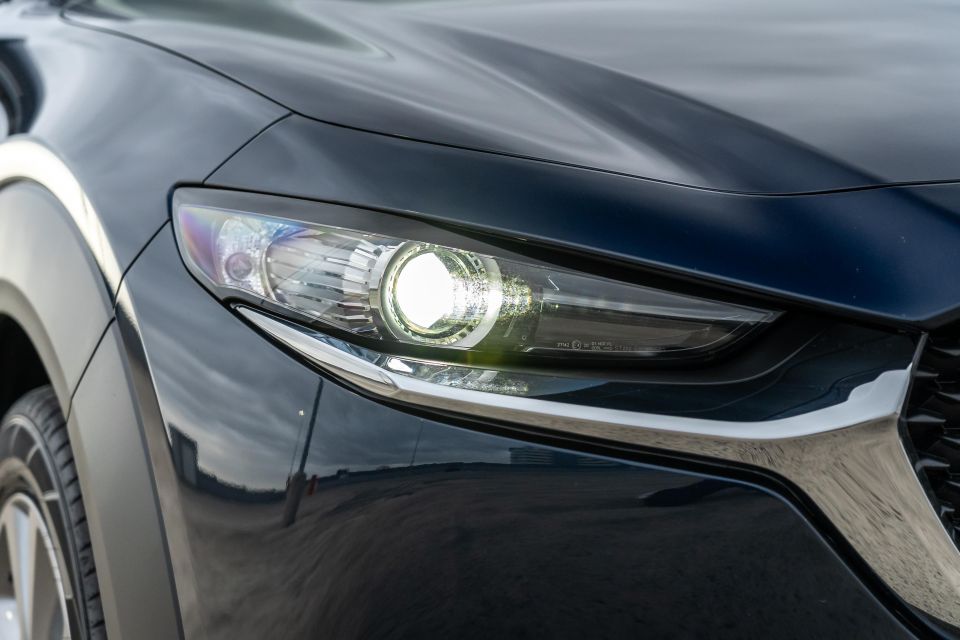

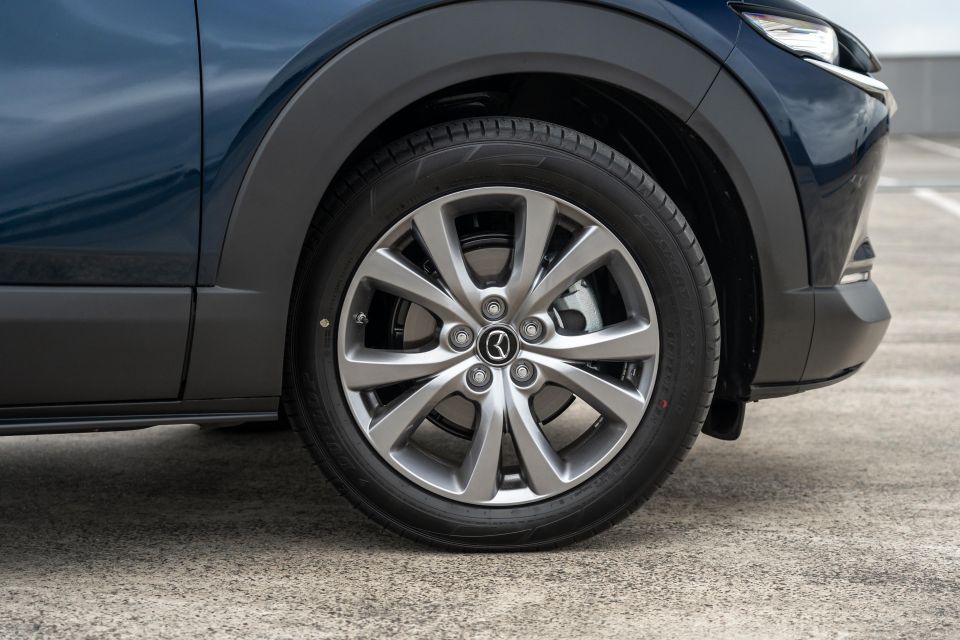
Common features between the two vehicles on test include LED headlights with auto high-beam, alloy wheels, satellite navigation, Apple CarPlay and Android Auto, DAB radio, keyless entry with push-button start, cloth seats, reversing cameras and rear sensors, automatic headlights and wipers, dual-zone climate control, and manually-adjustable front seats.
The Mazda one-ups the Ford with standard adaptive cruise control, blind-spot monitoring and rear cross-traffic assist, as well as a larger 8.8-inch display (versus 8.0-inches), projector headlights, larger 18-inch alloys, a 7.0-inch multifunction driver’s display, eight speakers (versus six), and rear air vents.
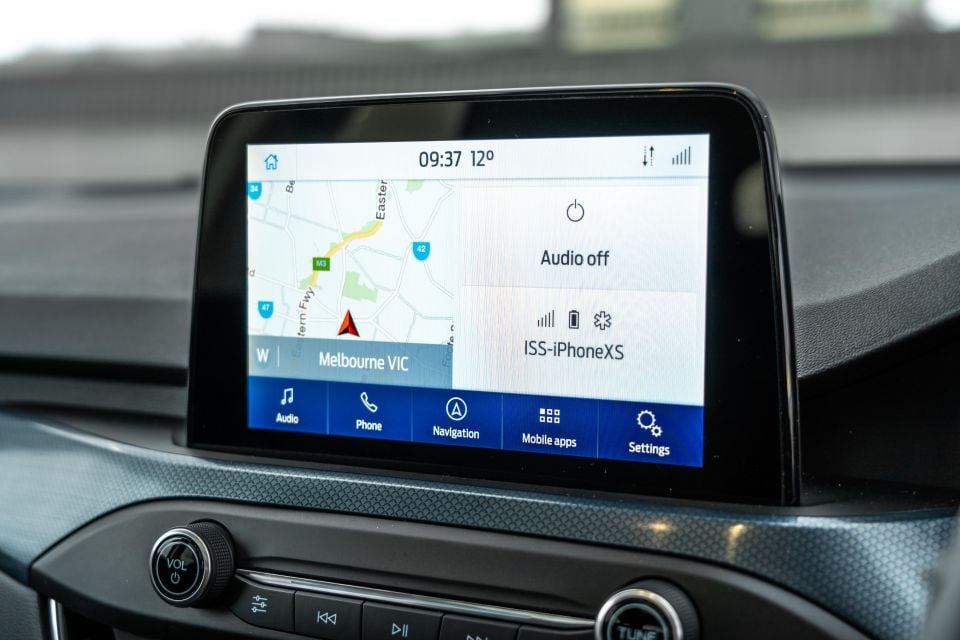
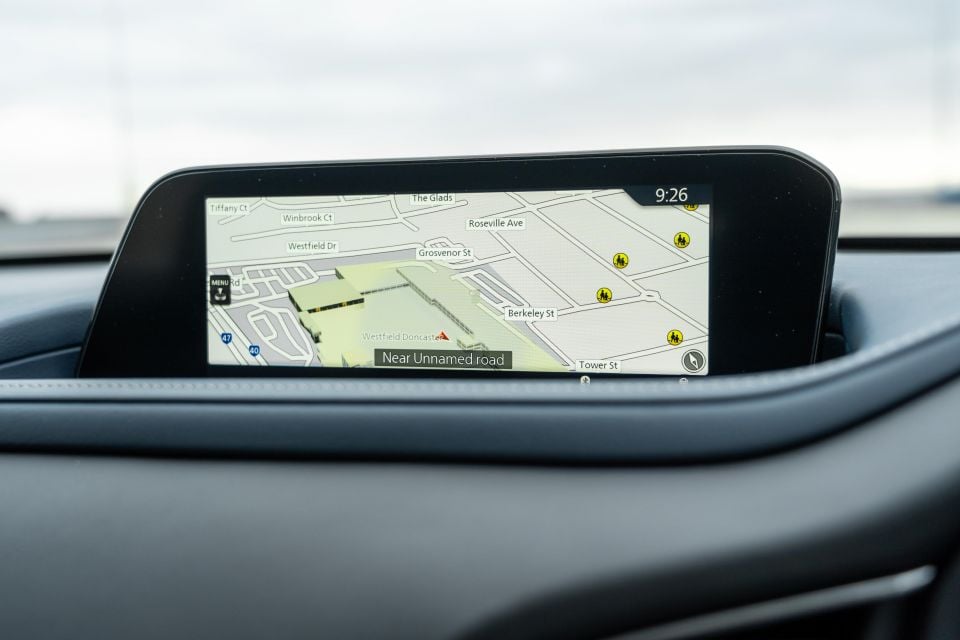
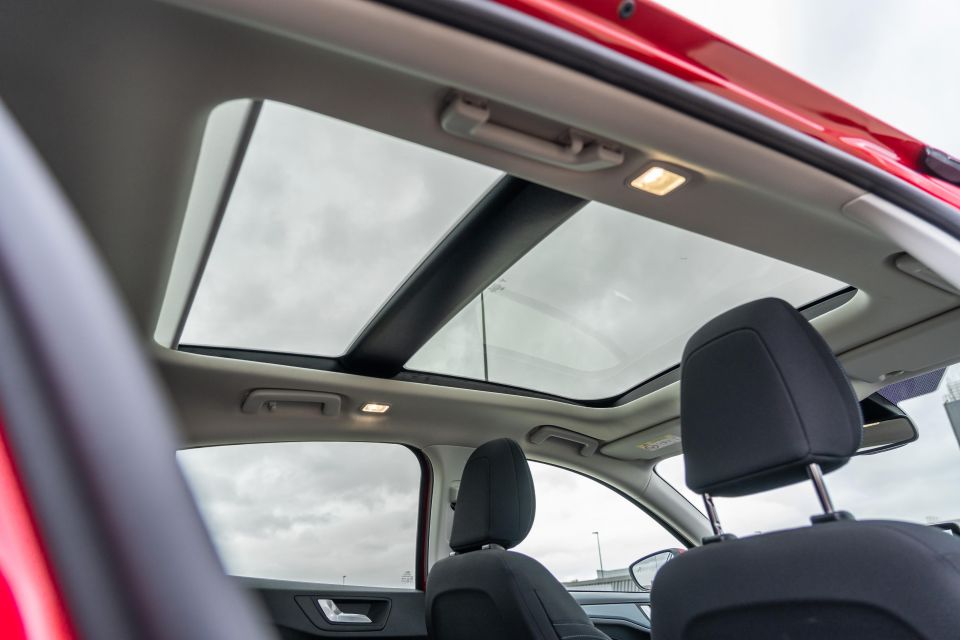

But the Focus gets connected car technology by way of the FordPass Connect embedded modem and mobile app, a more powerful engine with two extra cogs in the auto transmission (we’ll get to that in a bit), paddle shifters, touchscreen (versus a rotary dial in the Mazda), and a wireless smartphone charging pad.
With the optional Driver Assistance Pack, the Focus adds lane centring for the adaptive cruise control system, but that’s about it. The Panorama Pack, which includes the aforementioned panoramic roof, also adds a sunglasses holder and illuminated vanity mirrors.
Even without the optional Vision Technology Pack fitted, the Mazda pips the Focus in terms of standard specification.
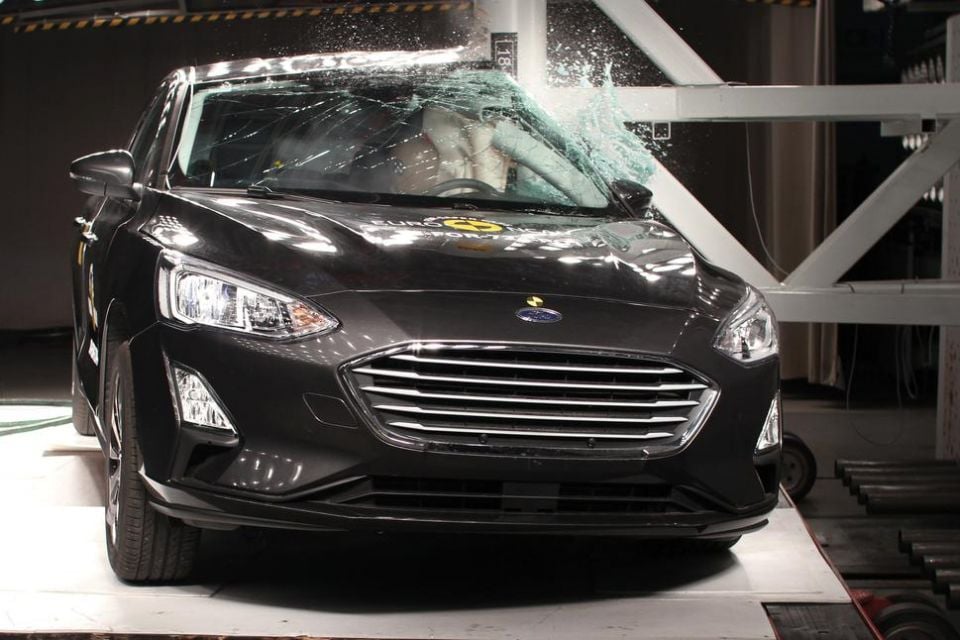
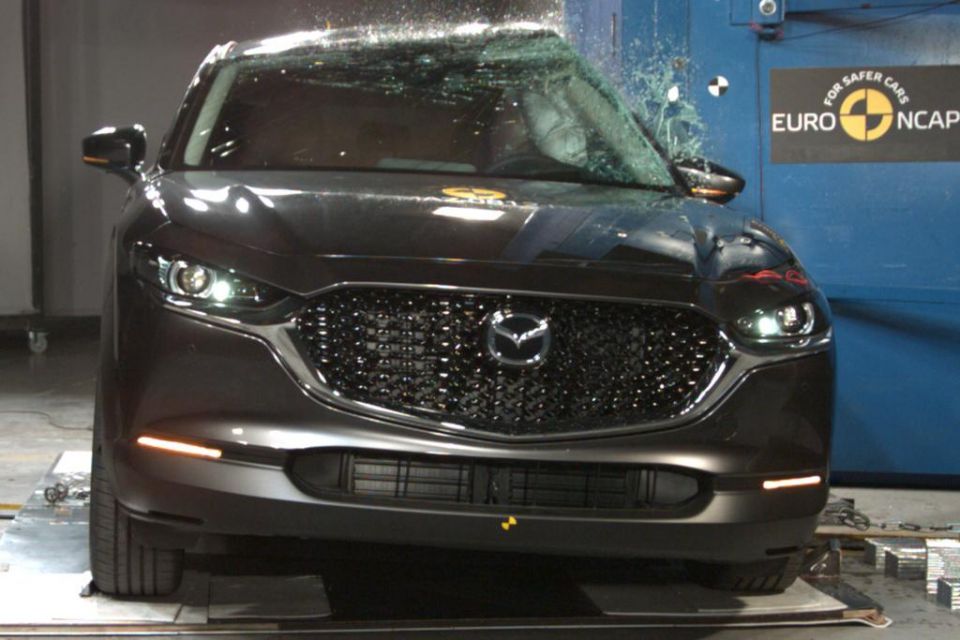
Both the Focus and CX-30 wear five-star ANCAP safety ratings with 2019 date stamps, based on tests conducted by sister firm Euro NCAP. The difference is in the category scores.
The CX-30 scored a near-perfect 99 per cent for adult occupant protection, and managed 88 per cent for child occupant protection, 80 per cent for the protection of vulnerable road users, and 76 per cent for safety assist.
Meanwhile, the Ford posted a still impressive score of 96 per cent for adult occupant protection, 87 per cent for child occupants, 72 per cent for vulnerable road users and 72 per cent for safety assist.
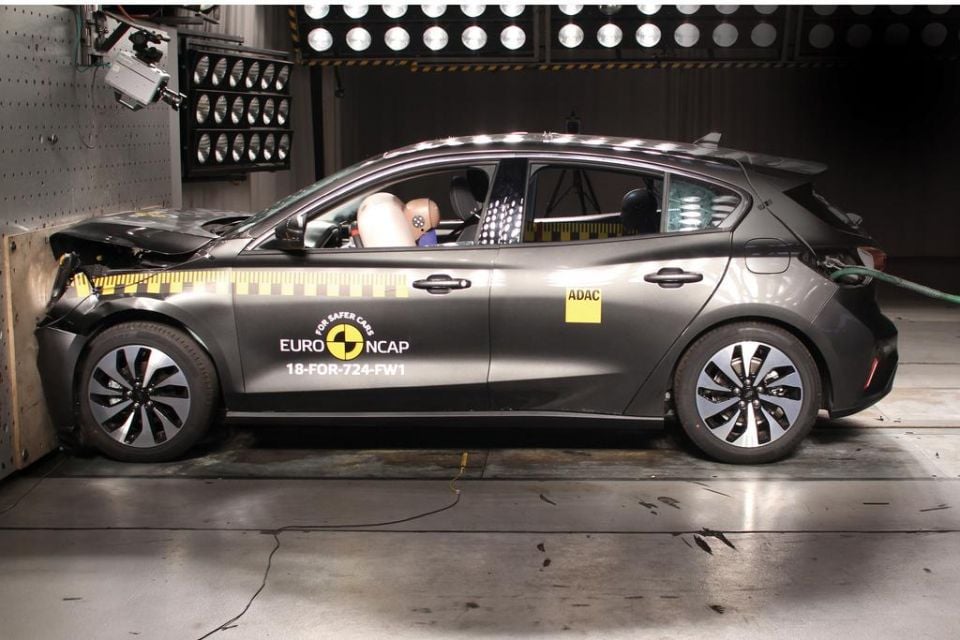
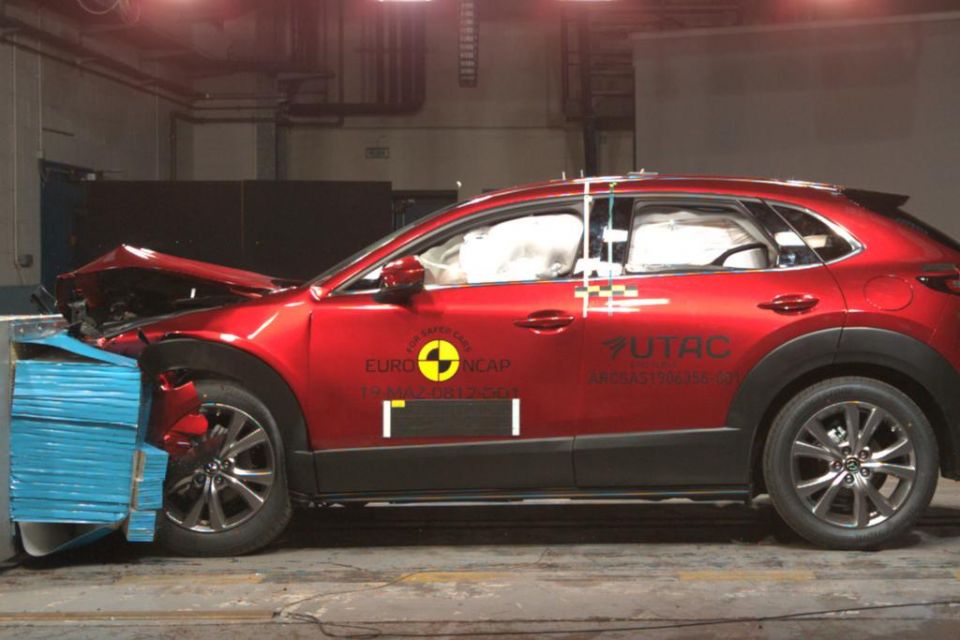
All in all, both cars are very safe.
In terms of safety equipment, both vehicles come equipped with autonomous emergency braking (AEB) with pedestrian and cyclist detection at city and interurban speeds, lane-keep assist as well as reversing cameras with guidelines.
The Mazda offers higher-end features like adaptive cruise control, blind-spot monitoring and rear cross-traffic assist as standard, though these features also form part of an optional package on the Focus.
Both vehicles feature dual front, side chest and side curtain airbags, though the Mazda uniquely features a driver’s knee inflator.
If safety is your number one priority, the data points to the Mazda as the better choice, if only by a small margin.
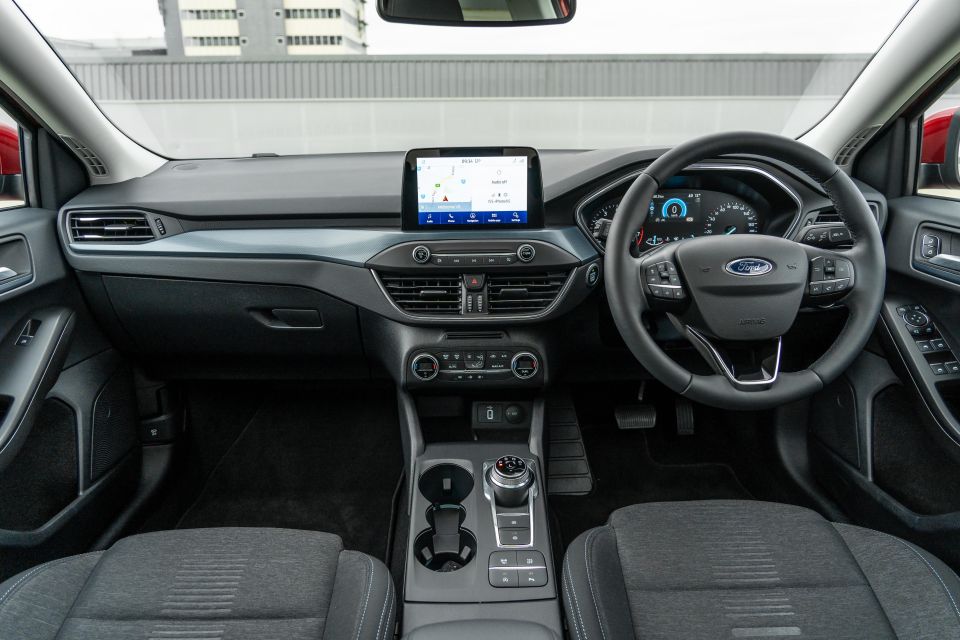
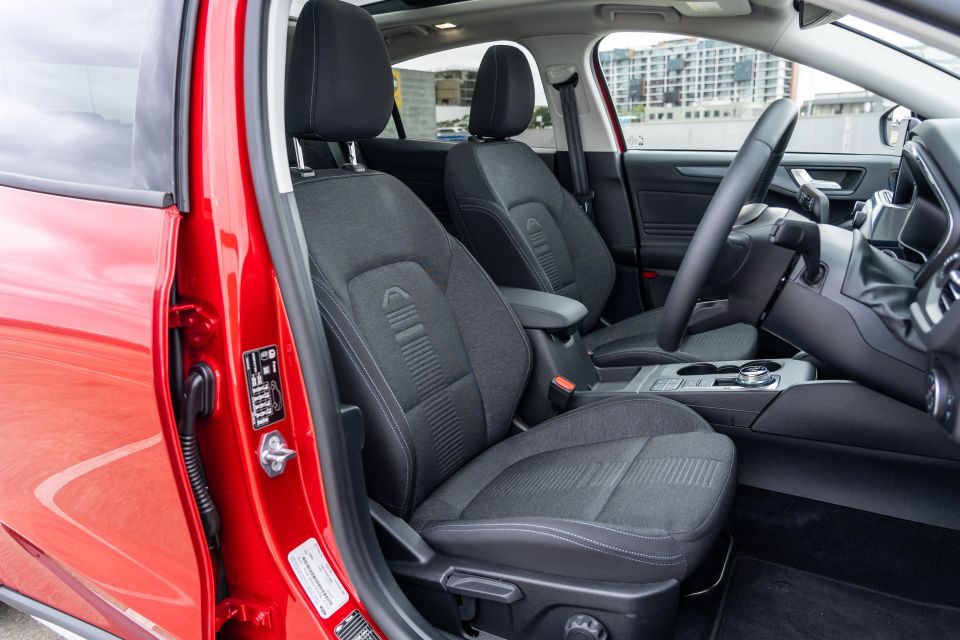
Focus Active
Being a derivative of the Focus rather than a standalone model, the Focus Active presents much like any other variant in the range with key differences being trimmings.
The Active gets its own special cloth trim, as well as trim inserts with an ‘A’ pattern signifying the ‘Active’ branding.
Otherwise, it’s all standard Focus here. There’s the chunky, leather-wrapped steering wheel, Jaguar Land Rover-esque rotary gear selector, high-set 8.0-inch touchscreen running Ford’s excellent Sync 3 software, as well as physical climate control switchgear.
There is a Germanic ambience in the mostly greyscale colour scheme, solid build quality with a good mix of soft-touch and hard-wearing surfaces, as well as fun little details like the cloth-lined door pockets – much like a VW Golf.
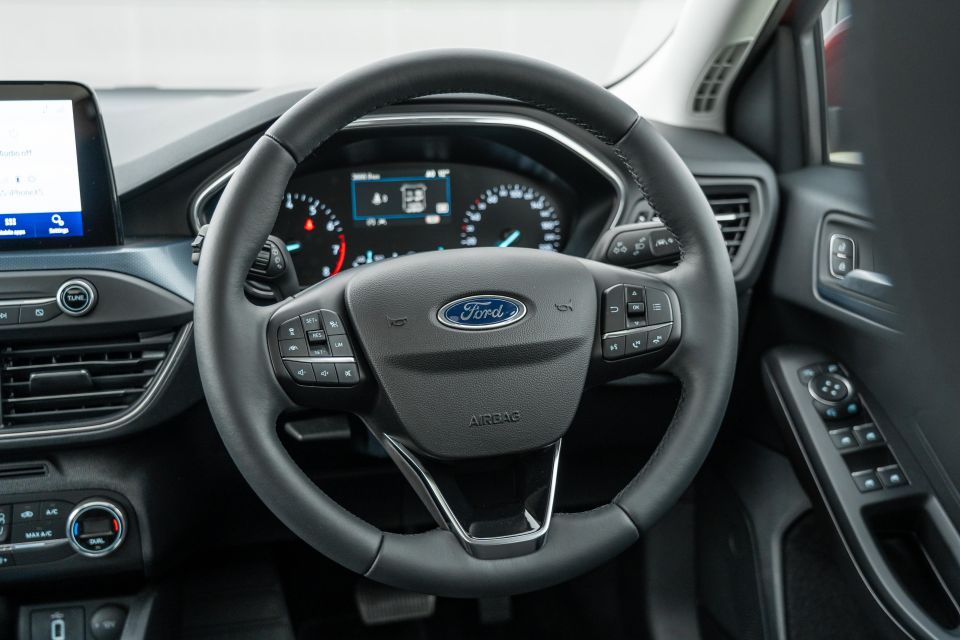
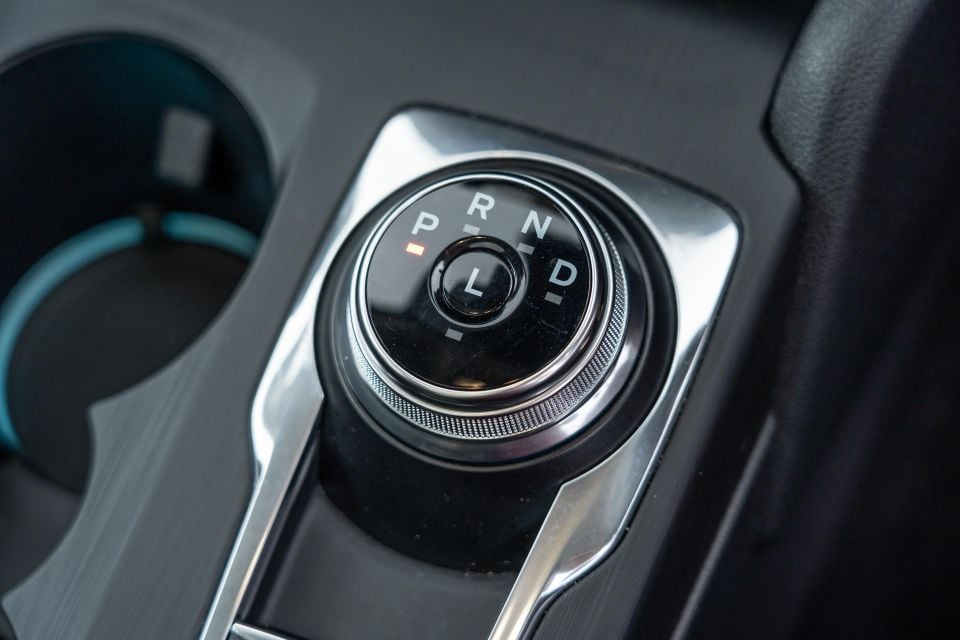

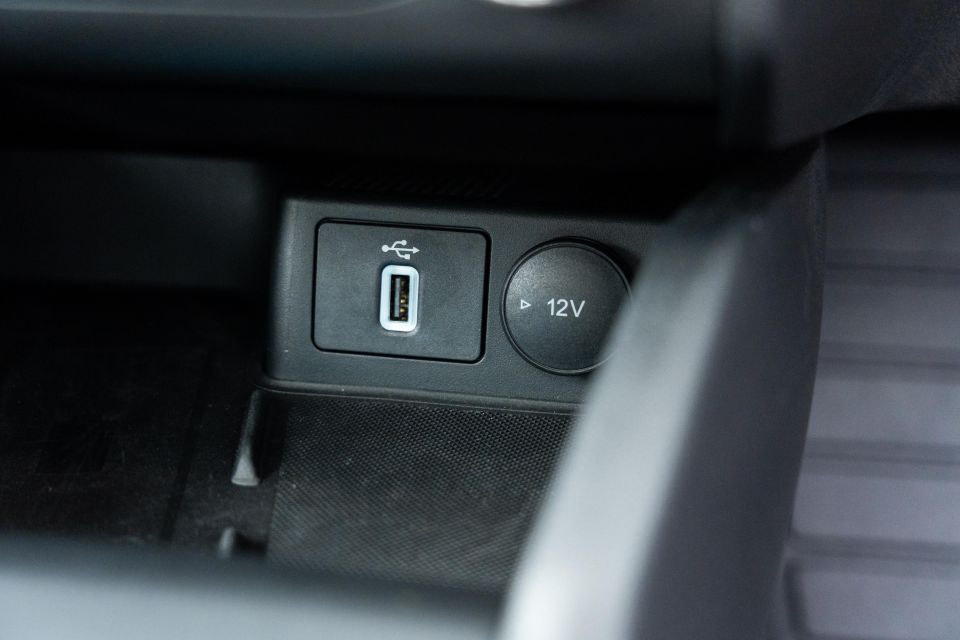
It’s all a little drab and uninspiring, though, and the cockpit design and overall fit and finish doesn’t wow you in the same way the Mazda does.
Comfort and space up front is really good, however. With a wide range of manual adjustment for the driver’s seat and steering wheel, it’s easy to fine-tune an ideal seating position, and the conventional analogue gauges with small digital display nestled between them are easy to read.
It’s a shame the 12.3-inch digital instruments from the Focus ST, Puma and Escape haven’t trickled down to the normal Focus models yet, and Australia no longer has the option of a head-up display.
Further omissions available elsewhere include padded knee rests on either side of the centre console, and many will lament the lack of leather trim option.
The infotainment system is easy to use and well featured – as we’ve found with previous Ford reviews – storage options are pretty good as well, and the wireless phone charging pad is a nice touch.
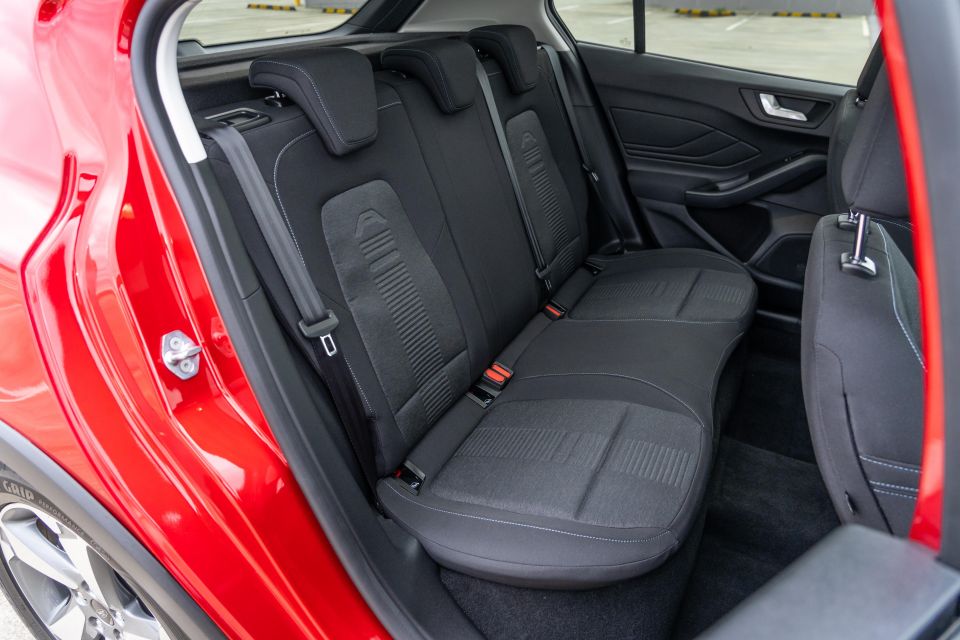
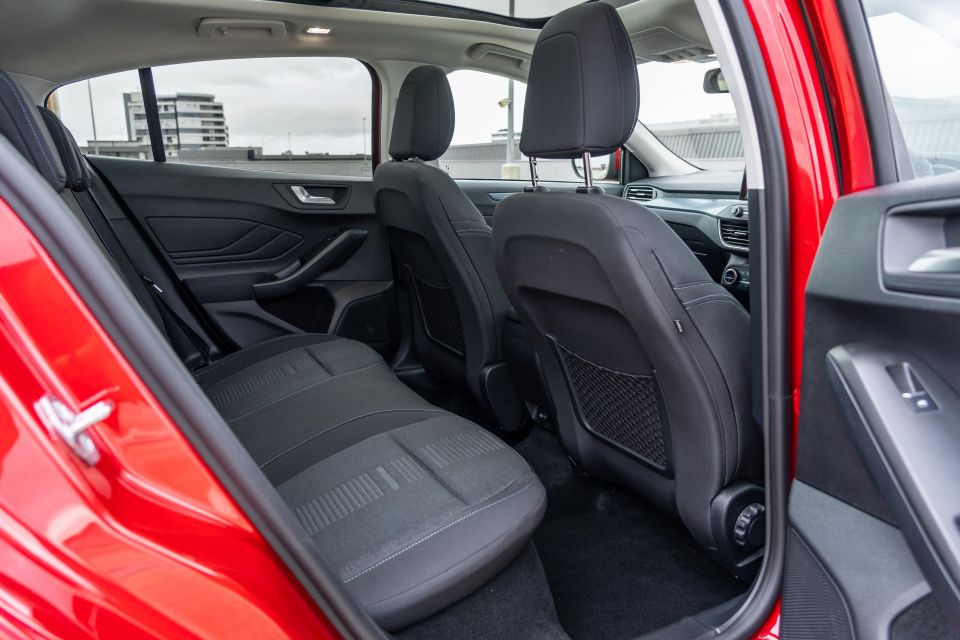
The second row is surprisingly spacious given the Focus doesn’t appear all that large – though at 4397mm long and 1844mm wide with a 2700mm wheelbase, it’s larger than the CX-30 in every dimension bar height.
I can fit behind my own driving position comfortably (I’m just over 6’1″) with head- and knee-room to spare even with the optional sunroof. There are ISOFIX child seat mounts for the outboard rear seats as well as top-tether points across the rear bench, as well as felt-lined bottle holders in the rear doors.
With that said, there are no rear air vents and no fold-down centre armrest with cupholders like you’ll find in numerous rivals – including the Mazda.

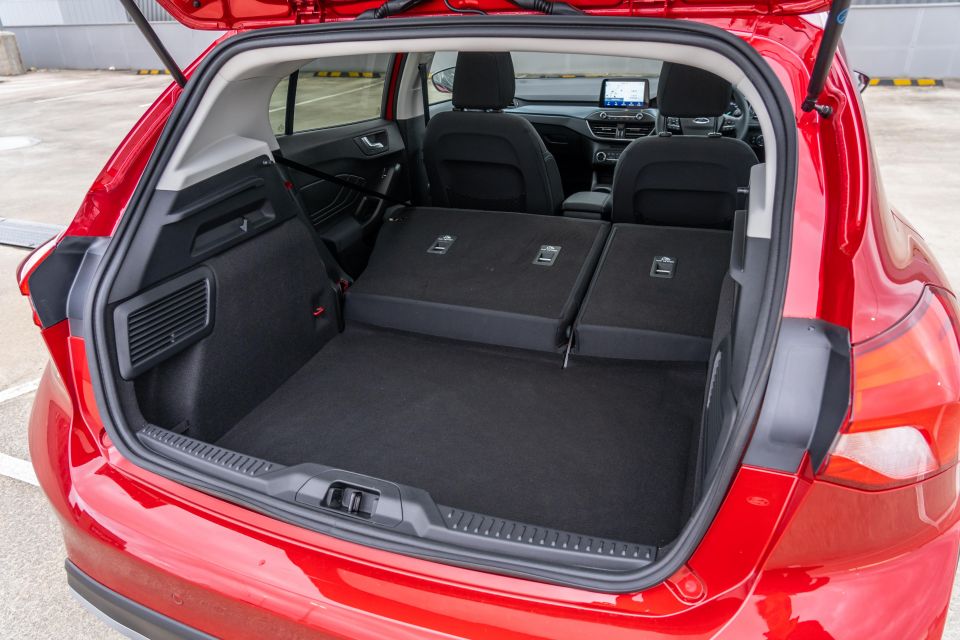
There are map pockets on the back of both front seats, as well as a 12V socket behind the centre console. No USB charge ports, though.
Where the Focus is a winner over its Japanese rival is in the boot area, which in five-seat configuration offers 341L which expands to 1320L with the rear seats folded.
The space itself is accessed via a wide opening, and is deep and square, so it shouldn’t be a challenge to fit large boxes or funny-shaped gear.
A space-saver spare wheel lives under the boot floor.
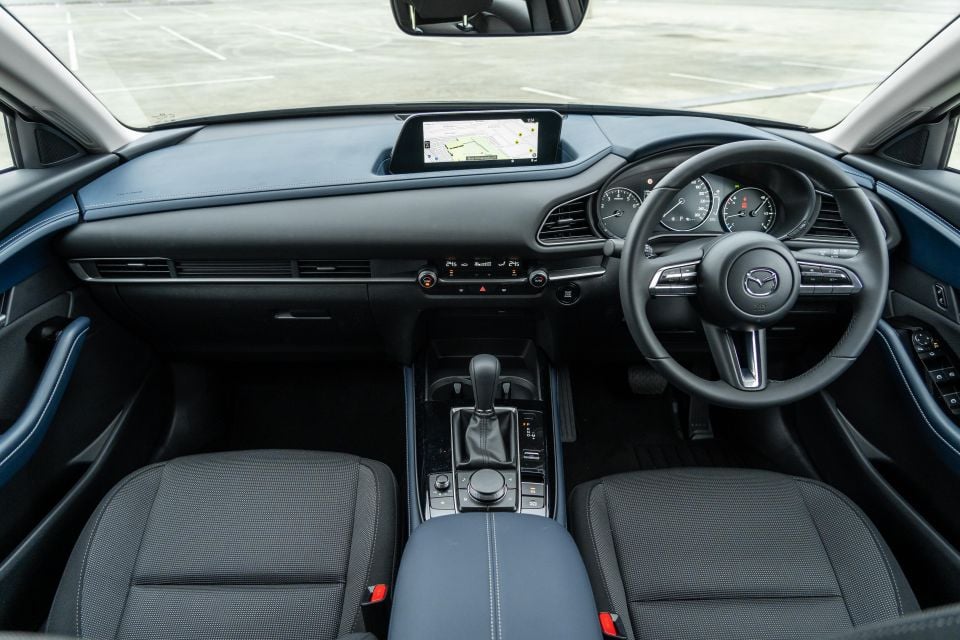
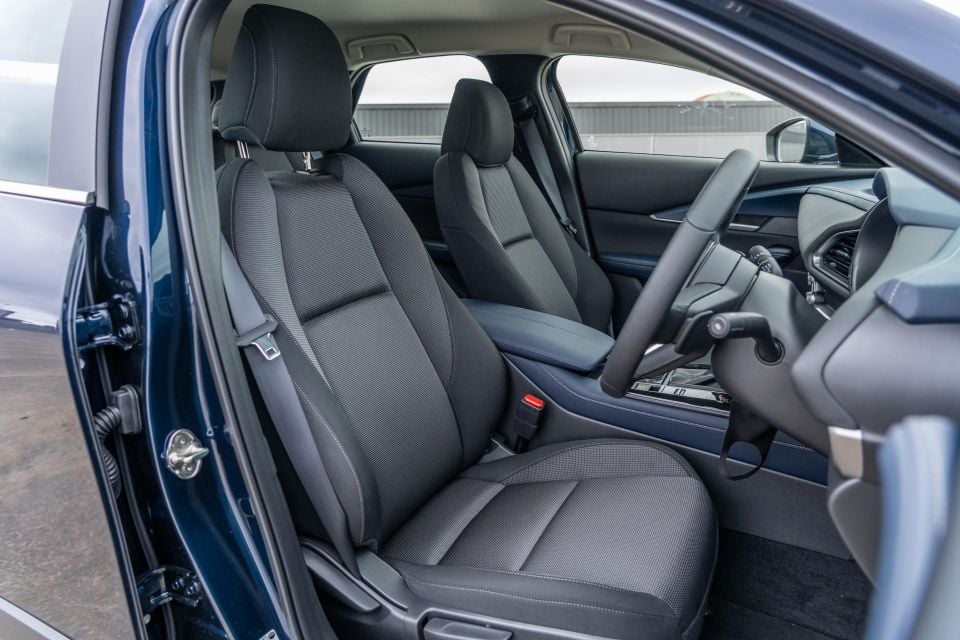
CX-30 G20 Evolve
Even at the lower end of the range, the Mazda CX-30 looks and feels like a premium product.
The design, surface touch points and tactility of the switchgear all feels befitting of a much more expensive car. I tend to draw comparisons with Lexus product – in the case of the CX-30 it’s not dissimilar to the UX crossover in design and execution.
From the lovely leather steering wheel, padded leatherette surfaces on the dashboard, doors and at knee-level along the centre console, as well as the comfort and contours of the front seats, it feels a lot more special.
All versions of the CX-30 get a classy 7.0-inch supervision cluster display incorporating a virtual speedometer with several layouts to toggle, while the physical buttons and rocker switches on the steering wheel are easy to use and feel good in operation.
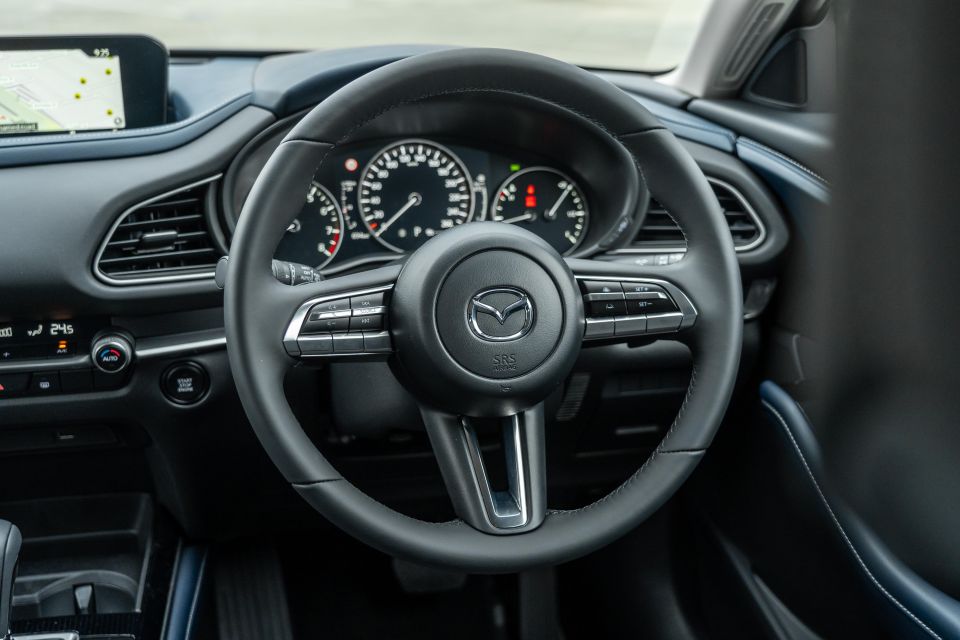


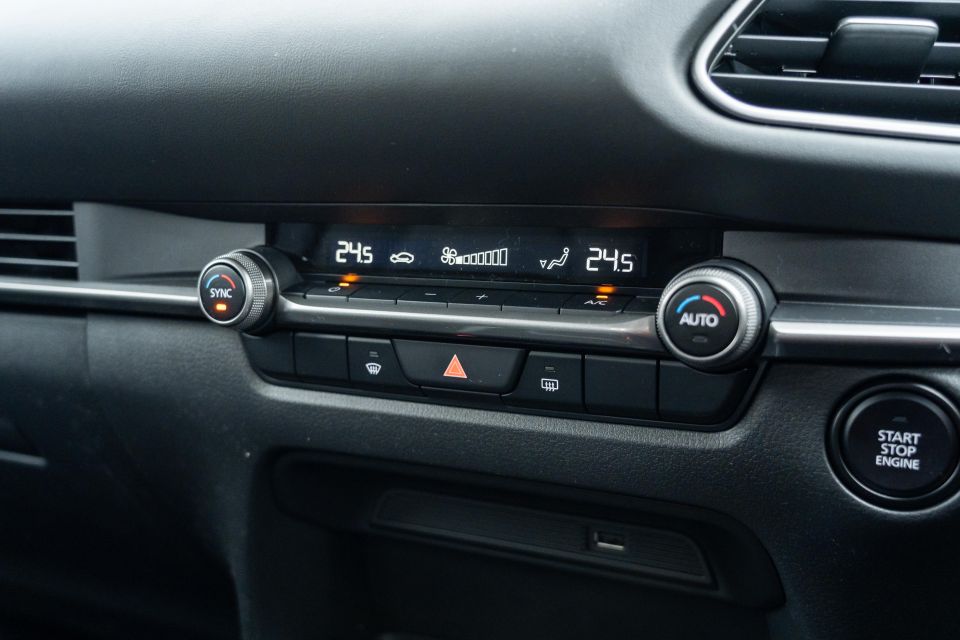
Where expert car reviews meet expert car buying – CarExpert gives you trusted advice, personalised service and real savings on your next new car.
The 8.8-inch widescreen infotainment system lacks the Ford’s touch inputs (instead opting for a rotary dial), but matches its rival for response, resolution and feature list. Having an additional two speakers also makes for fuller, clearer sound as well.
Even with a more minimalist approach to switchgear in the design, the HVAC controls remain physical buttons and dials, are ergonomically laid out and have a lovely tactile feel – especially the knurled effect on the rotary dials.
It’s all very clean and elegant, with a pop of blue for the dash, doors and centre armrest. This colour scheme certainly works with our tester’s Deep Crystal Blue paint, though it doesn’t quite match up with say, Soul Red Crystal.
Like the Focus there’s a good range of adjustment for the driver, all manual at this end of the range. Unlike most vehicles in the class, there’s even adjustment for the angle of the seat base – very European.
Storage up front is decent if not as good as the Ford, with shallower door bins but a much longer, deeper cubby under the centre armrest. There’s a shelf for your phone (albeit without a wireless charge pad), and two cupholders ahead of the shifter so drinks don’t get in the way of your forearm and elbow.
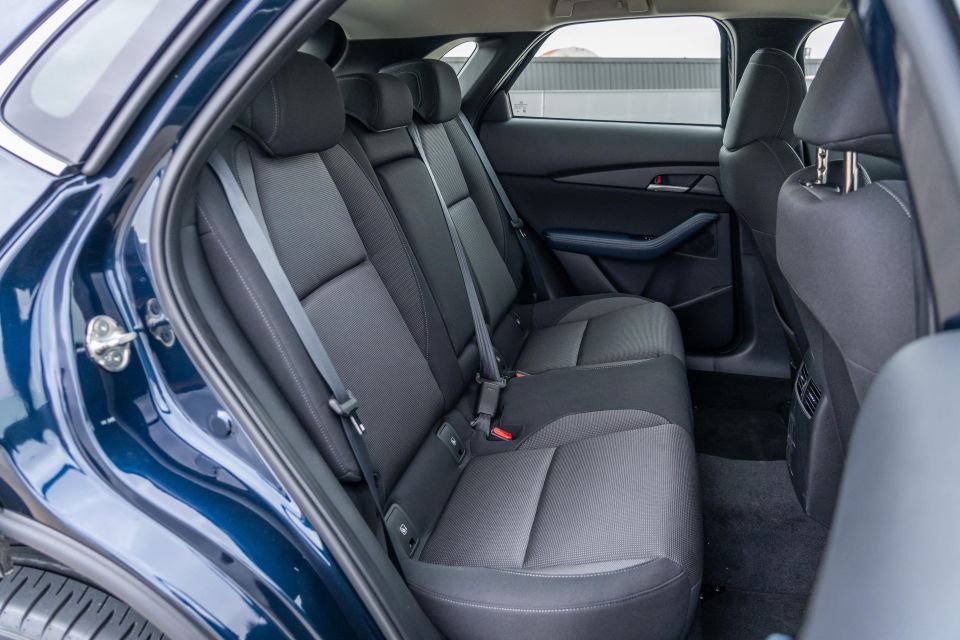
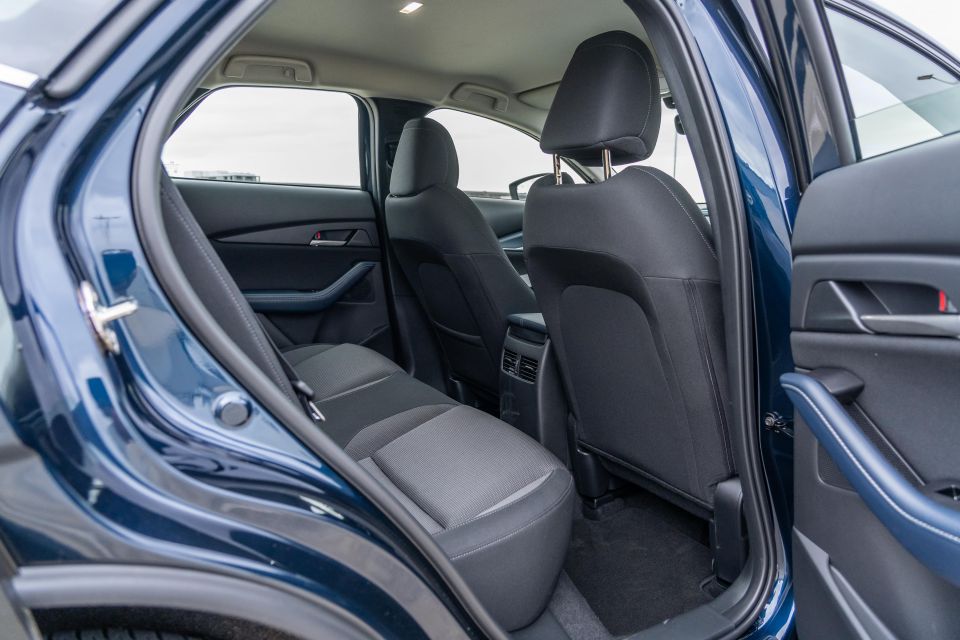
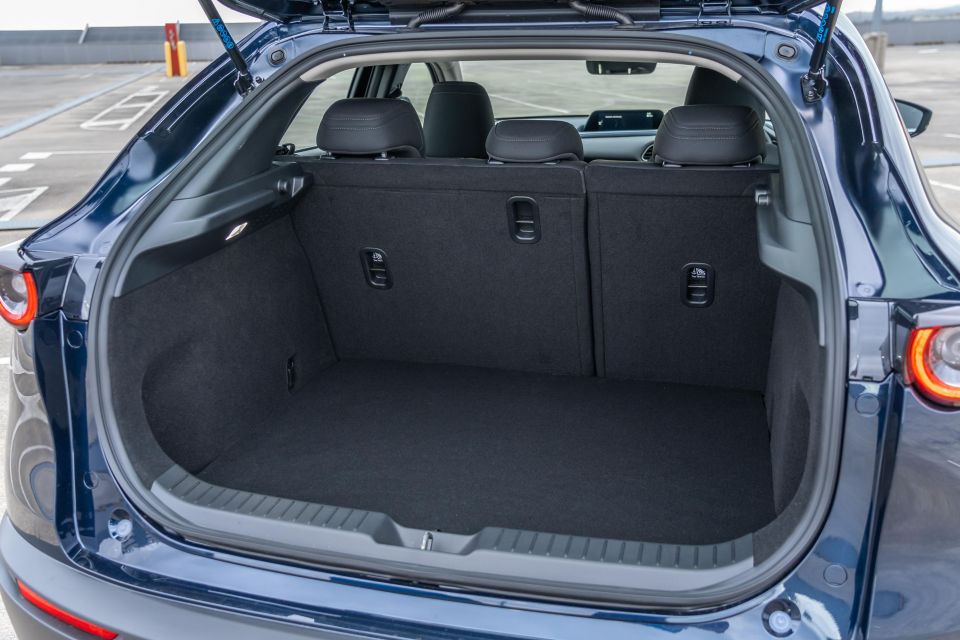

In the second row you’ll notice it’s a little more cosy in terms of kneeroom, and the smaller rear windows mean outward visibility for kids is more limited than the Ford. Sitting behind my own driving position, it’s a little tight.
There are, however, rear air vents which the Focus does without, as well as a fold-down centre armrest with cupholders that the Ford again lacks, though there’s no charge port in the back. ISOFIX anchors for the outboard rear seats are pretty standard these days, as are the top-tether points on all three rear seat positions.
Further back again, the Mazda CX-30 offers a quoted 317L of luggage capacity and doesn’t list a maximum capacity with the second row folded. A space-saver spare wheel lives under the boot floor.
It’s a tough pick for a winner in the cabin round. On one hand the Focus is more spacious if a bit clinical, while the Mazda is better finished and offers more amenities but at the cost of space for passengers and luggage.
| Ford Focus Active | Mazda CX-30 | |
|---|---|---|
| Length | 4397mm | 4395mm |
| Width | 1844mm | 1795mm |
| Height | 1483mm | 1540mm |
| Wheelbase | 2700mm | 2655mm |
| Boot | 341L | 317L |
| Clearance | 163mm | 175mm |
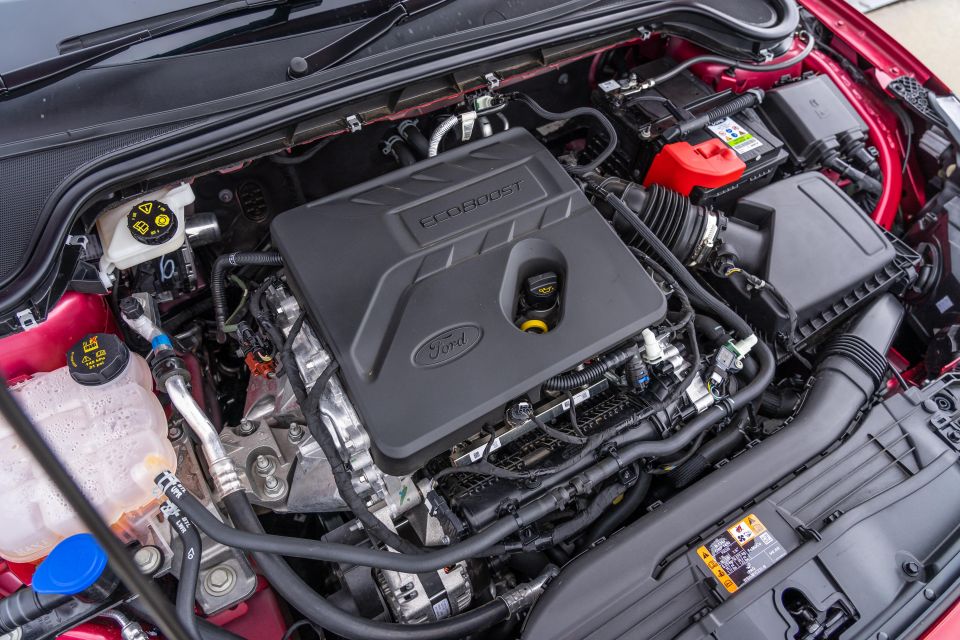
Probably the biggest difference between these two vehicles is what powers them.
The Ford Focus Active features the same 1.5-litre three-cylinder turbo petrol as other non-performance Focus variants, now limited to the ST-Line hatchback.
Outputs are rated at 134kW (6000rpm) and 240Nm (1750-5000rpm), with drive sent exclusively to the front wheels via an eight-speed automatic transmission.
Ford quotes combined fuel consumption of just 6.4L/100km, with 95 RON premium unleaded demanded as a minimum for the Focus’ 52L fuel tank.

Meanwhile, the Mazda’s powertrain offers more cubic inches but less outright punch, largely due to the lack of forced induction.
The familiar ‘G20’ 2.0-litre naturally-aspirated four develops 114kW (6000rpm) and 200Nm (4000rpm). Drive is sent to the front wheels via a six-speed auto.
Fuel consumption is rated at 6.5L/100km on the combined cycle, though the Mazda will happily run on 91 RON regular unleaded. Its fuel tank measures 51 litres.
Both vehicles feature idle stop/start technology as standard, though only the Mazda offers steering-mounted paddle shifters. The Focus offers numerous drive modes – Eco, Normal, Sport and several off-road modes – while the Mazda has a switch that toggles Sport mode.
| Ford Focus Active | Mazda CX-30 | |
|---|---|---|
| Engine | 1.5-litre turbocharged | 2.0-litre naturally aspirated |
| Cylinders | Three | Four |
| Power | 134kW @ 6000rpm | 114kW @ 6000rpm |
| Torque | 240Nm @ 1750rpm | 200Nm @ 4000rpm |
| Fuel economy | 6.4L/100km, 95 RON | 6.5L/100km, 91 RON |
| Power-to-weight | 101.4kW per tonne | 83.8kW per tonne |
| Towing capacity | 1200kg | 1200kg |
| Transmission | Eight-speed auto | Six-speed auto |
| Driven wheels | Front | Front |
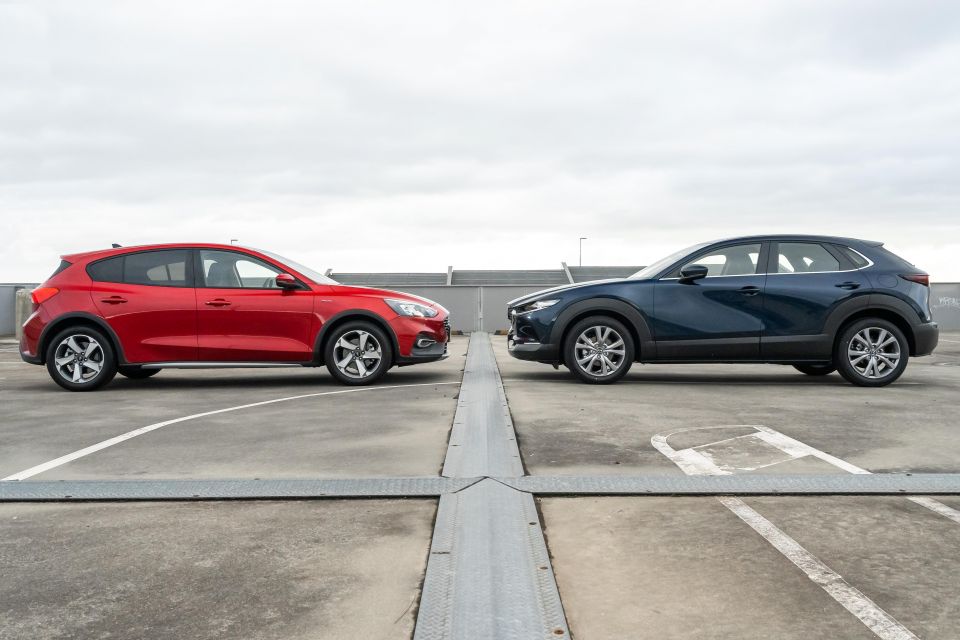
Focus Active
If you want your SUV to drive like a sporty hatchback, then the Focus Active is probably going to be the best option – not just here, but across the segment.
Riding some 30mm higher than a standard Focus hatchback (or about 40mm higher than the lowered ST-Line) the Active is still pretty low relative to other small crossovers, quoting ground clearance of just 163mm, 12mm less than the Mazda.
So you’ve got a lower centre of gravity, plus the fact it’s longer and wider than the Mazda (and with a longer wheelbase), so there’s quite a hunkered-down feel to it.
Like other models in the Focus range, the Active shines in terms of responsiveness and driver engagement. The steering is sharp and accurate, there’s plenty of pulling power from that thrummy turbocharged three-cylinder engine, and the chassis cuts a fine balance of ride comfort and dynamic prowess.
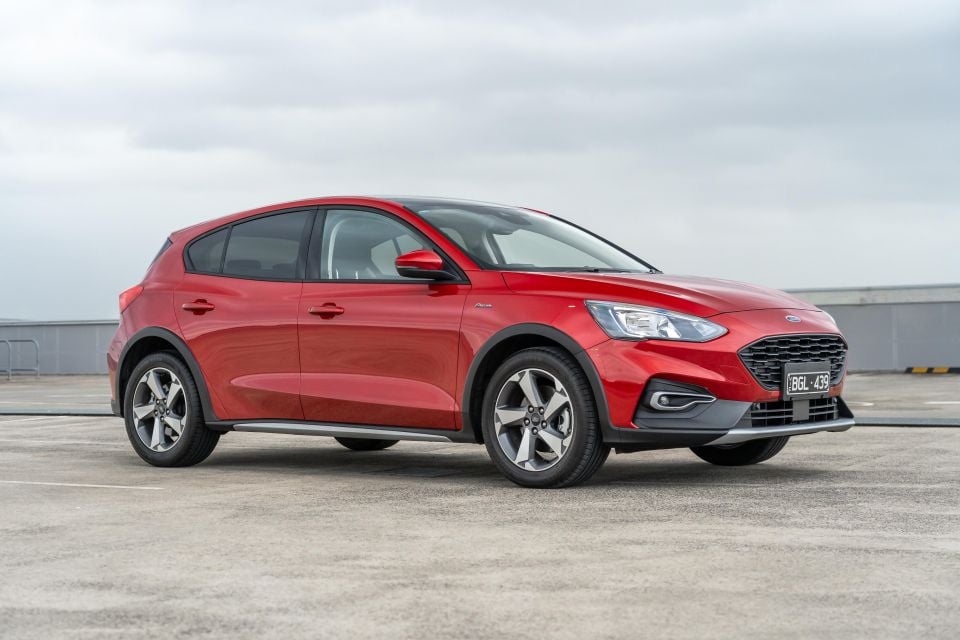
The chunky 215/55 R17 Goodyear Efficient Grip tyres offer plenty of grip in everyday driving, and even in adverse weather there’s rarely the feeling you need all-wheel drive. At its core, the Focus has been designed to be doing well over 200km/h on the German Autobahn – a little rain and wind doesn’t faze it at all.
It’s surprisingly comfortable in urban commuting as well, despite its ST-Line sibling being one of the firmer small hatchbacks. The comfort tune plus added ride height add a level of compliance that makes it easily the most comfortable Focus variant on sale in Australia.
Dial up the pace and the curves a bit and the Focus Active impresses the same way its standard hatchback sibling does. As noted earlier it turns in keenly, has good body control, and engine performance is a highlight, more so against similarly-priced small SUVs.
Even the Puma, which is actually based on the smaller, cheaper Fiesta platform, can’t match the breadth of the Focus Active’s talents. Another reason why I feel the Focus Active is one of the Australian market’s best-kept secrets.
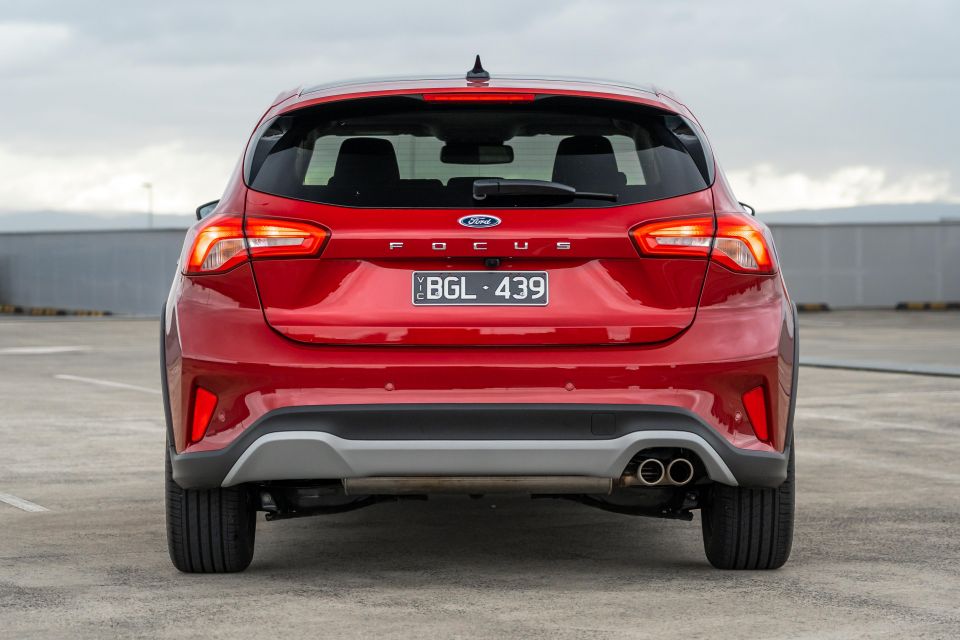
On the open road the Focus happily hums away in eighth gear and the optional adaptive cruise and lane centring systems work a treat.
It’s a shame these features aren’t standard, because they’re actually pretty darn good in operation and the lane-keep and lane centring functions don’t feel as intrusive as some rival systems.
Refinement on the freeway is likewise pretty good. We feel the Mazda is a touch quieter and better insulated from the outside world, but the Focus is by no means sub-par in this area, especially against other competitors in the small SUV class.
Visibility is likewise great, and the quick steering while a touch on the heavier side means parking this thing isn’t a tough ask. This task is aided by a clear multi-view reversing camera. The fat rear haunches may take a bit of getting used to, though.
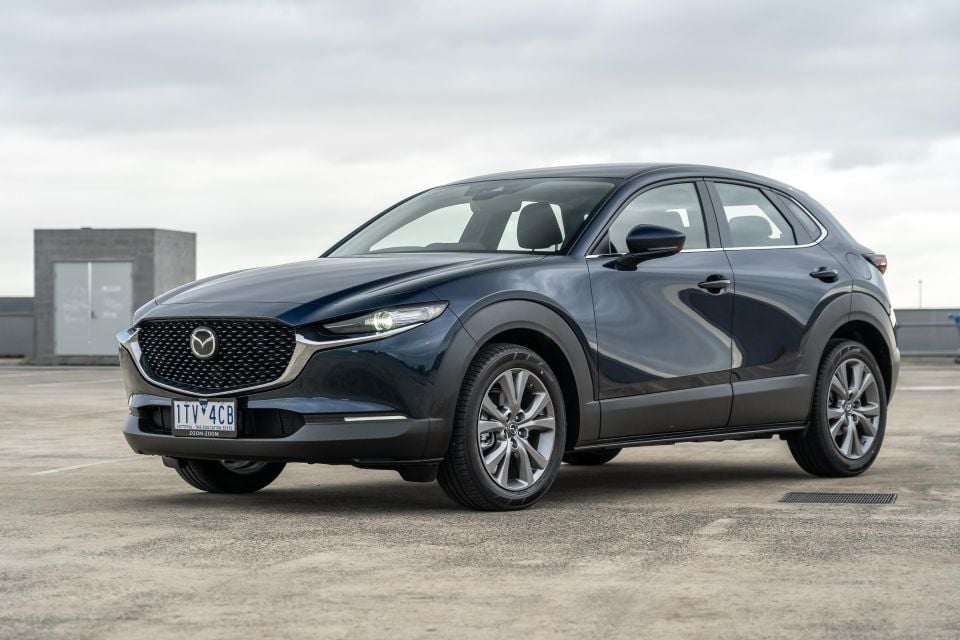
CX-30 G20 Evolve
As soon as you set off in the Mazda, its more relaxed, refined persona is immediately apparent.
There’s a more insulated ambience, response from the 2.0-litre atmo four is more progressive and linear with less urgency than the Ford, and the driver controls don’t seem as twitchy.
That’s not to say the Mazda isn’t lovely to drive, because it is.
Last year I reviewed this same G20 Evolve specification, and knocked it quite hard for the barely adequate performance of the 2.0-litre engine. At the time we were in between Melbourne lockdowns, so I wasn’t driving to work everyday and doing more stints on the freeway visiting family and friends.
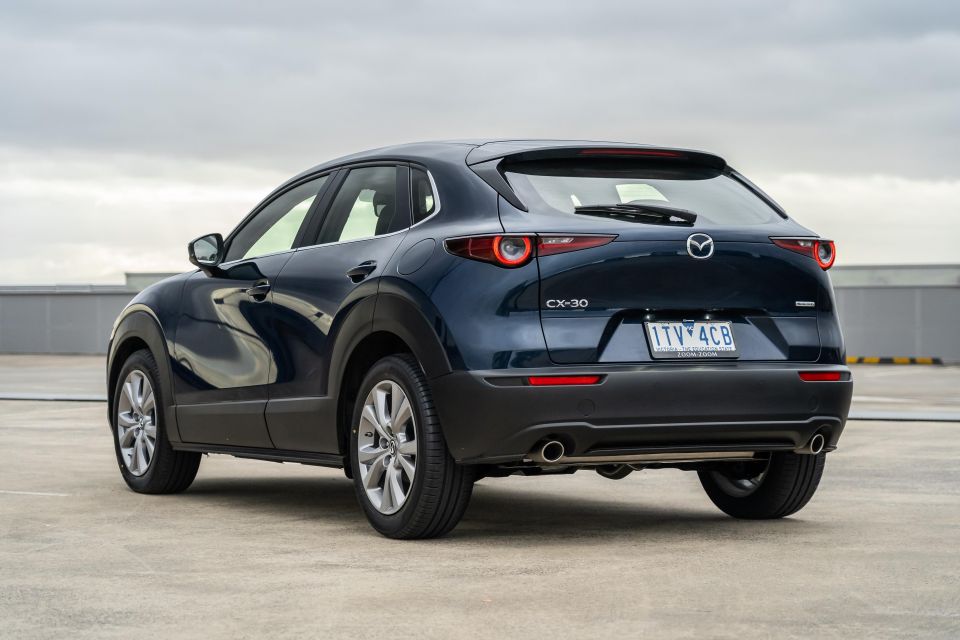
That assessment with regards to its open road performance still holds true, and we’ll get to that in a bit, but after some time driving the CX-30 in peak-hour Melbourne traffic, I can see this model’s appeal more.
The 2.0-litre’s linear, rev-happy nature makes it a great fit for the daily commute. It’s pretty refined, though a bit gruff on cold start which seems to be a characteristic of Mazda’s petrol engines, and is responsive enough to get the job done without fuss.
It’s also super smooth, and the six-speed automatic offers snappy shifts and is quick to respond when you sink your boot in for a bit more shove. The idle stop/start system is likewise one of the better of its type, being quick to start up and get going once the lights turn green.
You start to find its limits though, once the speed hits triple digits.
Getting up to 100km/h isn’t really the issue, it’s more dealing with undulating terrain and overtaking at those speeds where the 2.0-litre mill is a little out of its depth.
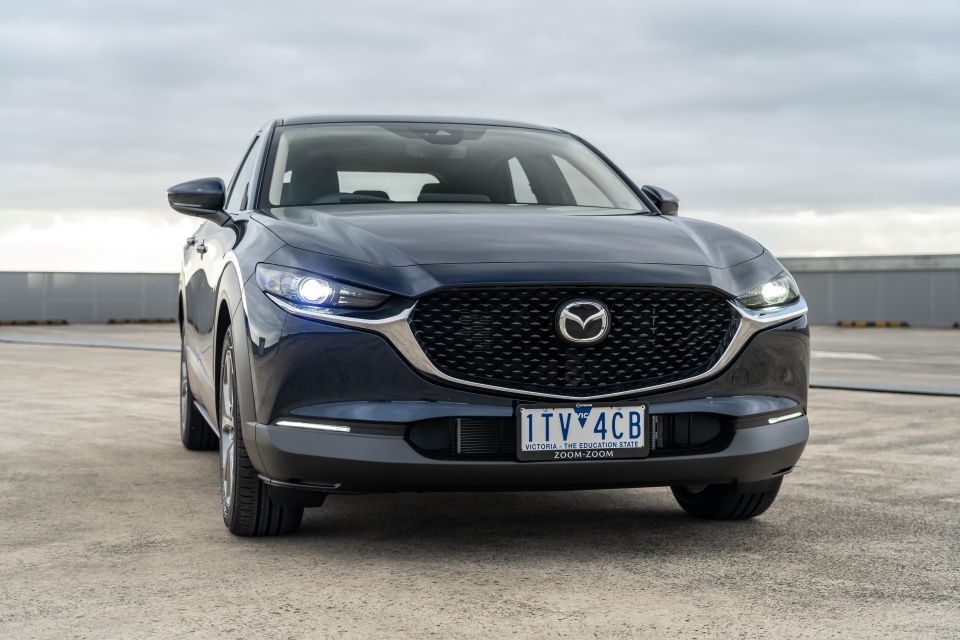
Up a decent enough hill with cruise control engaged, you’ll notice the transmission hunting through gears and the engine revving hard to maintain the set speed. It’s also spinning a bit over 2000rpm which transmits a bit more of the buzzy engine note into the cabin than we’d like.
It’s mainly amplified by the fact the fundamentals are otherwise excellent, with a sure-footed, confident feel at high speeds as well as one of the most insulated cabins from road/wind noise in the class. Should you do more highway and freeway driving, we’d suggest looking at one of the G25 2.5-litre models (from $36,690).
The CX-30 is a fun thing to steer as well, if quite a bit different to the Focus as noted earlier.
Where the Ford is almost itching for you to turn the steering wheel, the Mazda’s controls are lighter but fluid, progressive and accurate, with a layer of insulation in the feedback which makes driving effortless and almost relaxing.
It’s very Euro – I’d go as far to say Audi-like – in feel, though it’s got a level of feedback and play in the chassis to make it a bit of fun whether you’re darting through city streets or navigating a twisty B-road.

Like its Mazda 3 platform mate, the ‘zoom zoom’ feel is more playful than sharp like say, the Ford. There’s a bit of natural body roll in bends akin to an MX-5, but with plenty of grip and accuracy in the steering to make it chuckable and fun.
If you’re feeling particularly racy, you can flick the transmission into its manual mode and change gears via the steering-mounted paddle shifters.
That play in the chassis also translates to a comfortable, compliant ride. Even with a torsion beam rear axle and larger 18-inch alloys shod in 215/55 Dunlop SP Sport Maxx rubber, the CX-30 does a great job of isolating the cabin from bumps.
We have to praise Mazda for including almost the entirety of the available driver assist catalogue across the range, with the G20 Evolve’s standard adaptive cruise control, blind-spot monitoring and rear cross-traffic alert systems all proving handy in real-world use.
That said, the array of bongs and chimes when the vehicle notifies you of a car or cyclist in your blind spot can get a bit annoying, especially on a peak-hour drive when you’re slipping into tighter gaps in heavy traffic.
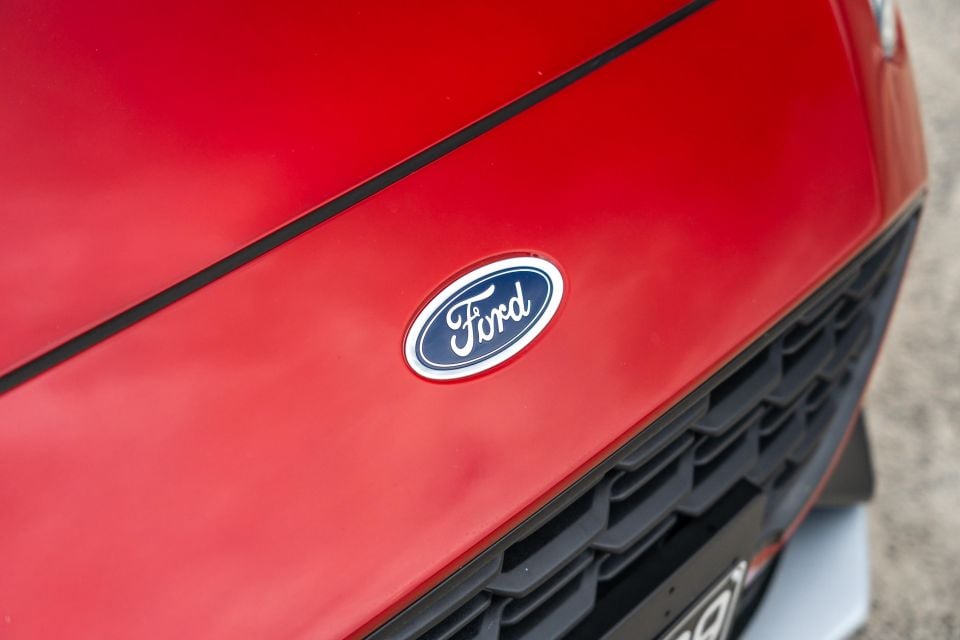
Both vehicles are covered by five-year, unlimited-kilometre factory warranties.
Mazda offers roadside assistance for the same five-year period as the warranty, while Ford’s roadside assistance – which is part of complementary auto club membership with each service – covers up to seven years provided you service your vehicle at a participating Ford dealer.
The Ford requires servicing every 12 months or 15,000 kilometres, whatever comes first. Each of the first five services costs $299, $299, $299, $299 and $350 – totalling $1546 for 60 months or 75,000km.
It also includes access to the Ford Service Benefits program, which includes roadside assistance through complementary auto club membership, and yearly satellite navigation map updates.
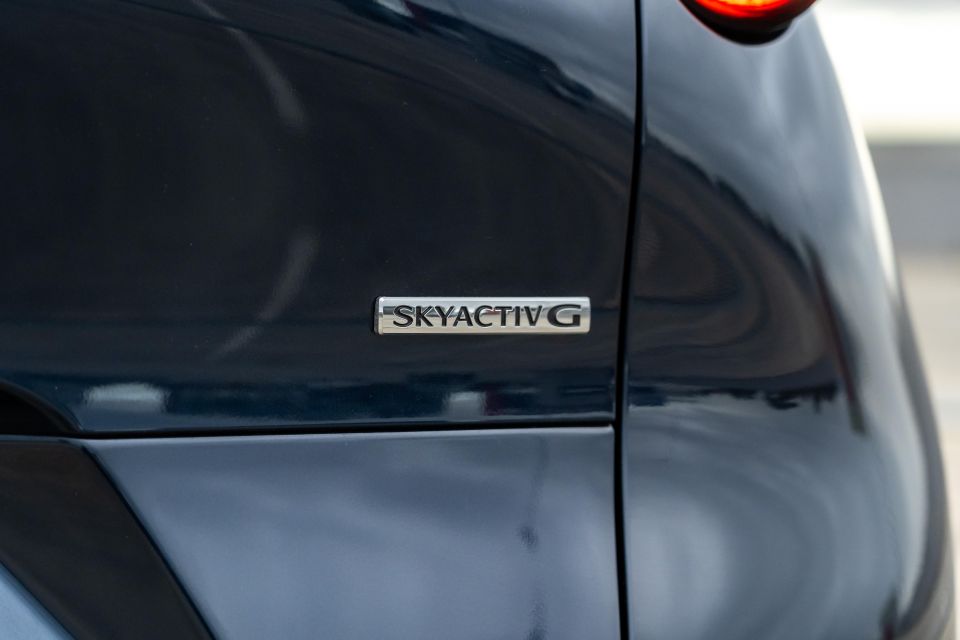
The CX-30’s intervals are slightly shorter, at 12 months or 10,000 kilometres. For the first five visits, it’ll cost $316, $361, $316, $361 and $316 – totalling $1670 over 60 months or 50,000km.
On top of that there’s additional service items including replacement of the cabin air filter ($103 every 40,000km) and brake fluid ($71 every 24 months/40,000km).
In terms of fuel consumption, both vehicles on test averaged in the eights during our testing, which including a mix of peak-hour commuting, freeway driving and shorter urban commutes. Both were a bit up on their mid-six-litre claims.
It’s worth flagging we commenced testing right has Victoria went into a snap two-week lockdown, so we weren’t able to do extended testing back-to-back as we would usually for a better idea of real-world fuel consumption.

Neither of these vehicles are a ‘loser’ in this comparison, rather offering different takes on a similar formula – the pick for you largely depends on your tastes and requirements.
The Ford is sportier to drive, has a punchier engine, feels more like a regular hatchback in most areas, and offers the more spacious cabin and boot.
The Mazda is a bit more SUV-like, has a more luxurious feel in both cabin trimmings and drive experience, and is also better value for money in terms of standard equipment.
For me personally, while I’m drawn to the performance and dynamics of the Focus, the Mazda’s quieter, more luxurious cabin is definitely where I’d prefer to spend my daily commute in.
With that said, the Focus is objectively a slightly better all-round package than the CX-30 in this specification, and certainly deserves to be selling in much higher numbers.
Click the images for the full gallery
MORE: Ford Focus news, reviews, comparisons and videos MORE: Mazda CX-30 news, reviews, comparisons and videos
Share your thoughts with us in the comments below!
James Wong is an automotive journalist and former PR consultant, recognised among Australia’s most prolific motoring writers.
Share your thoughts and write a review of a car you own and get featured on CarExpert.


Damion Smy
6 Hours Ago
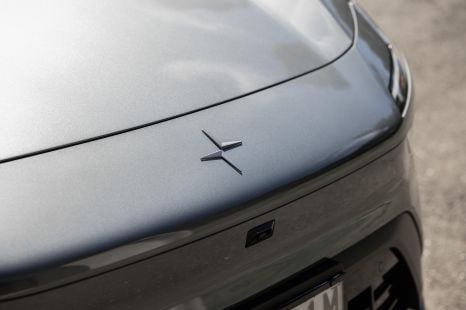

Damion Smy
7 Hours Ago


Damion Smy
8 Hours Ago


Damion Smy
11 Hours Ago


CarExpert.com.au
12 Hours Ago


Ben Zachariah
14 Hours Ago